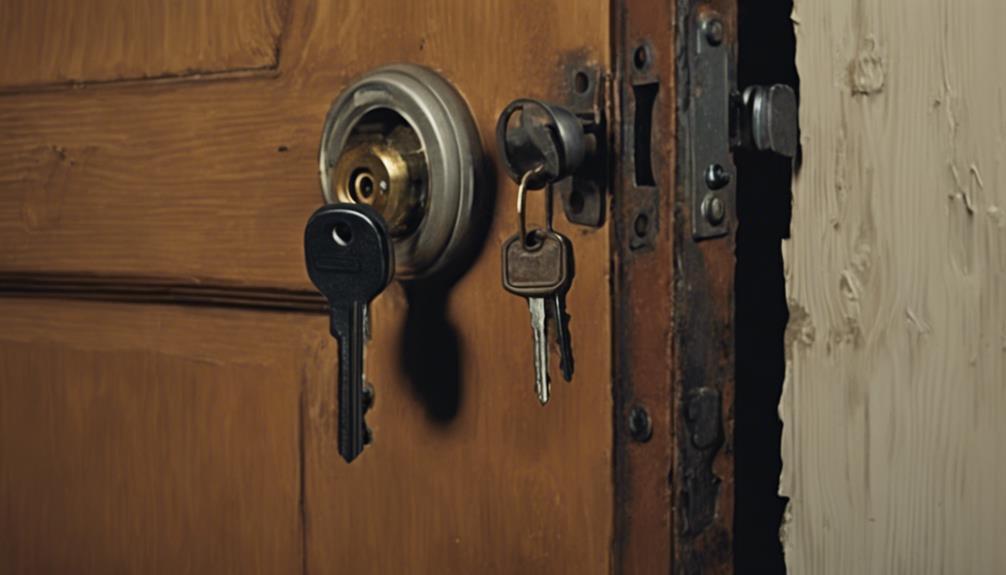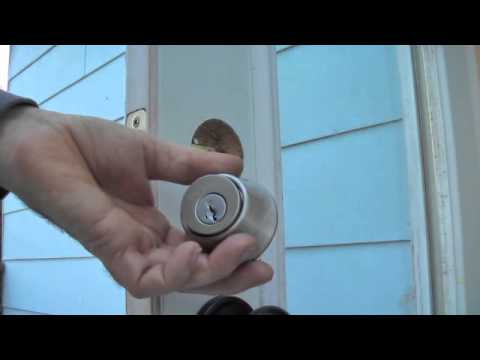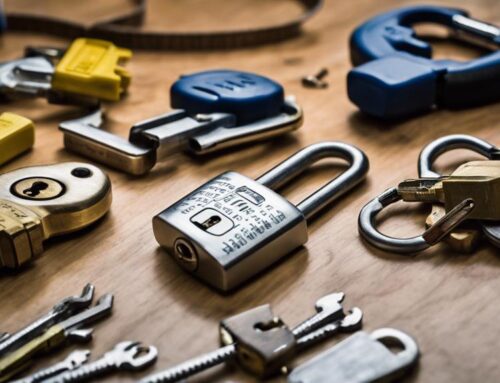When your lock is sticking, it's important to act fast to avoid further issues. First, check for dirt or debris inside the lock and clean it with compressed air. Lubricate the mechanism using graphite powder or silicone spray for smoother operation. If the lock still sticks, inspect the strike plate for misalignment and adjust it as necessary. You can also gently wiggle the key while turning it to relieve pressure. Regular maintenance is key to preventing future problems. There's more to learn about maintaining locks and ensuring they function well.
Key Takeaways
- Identify the cause of sticking, such as dirt accumulation, misalignment, or extreme weather conditions affecting the lock's operation.
- Clean the lock mechanism using compressed air and a soft cloth to remove dust and debris.
- Apply graphite powder or silicone spray for lubrication; avoid oil-based products that attract dirt.
- Check and adjust the strike plate alignment to ensure smooth lock engagement and operation.
- If sticking persists despite maintenance, consider replacing the lock for improved security and functionality.
Identify the Cause of Sticking
When your lock starts sticking, it's crucial to pinpoint the cause right away. A sticky door lock can lead to frustration—not just for you but for anyone trying to enter or exit.
First, consider whether dirt or debris is causing the lock jamming. Sometimes, dust accumulates inside the mechanism, preventing it from operating smoothly. Additionally, loose locks can pose security risks, making it important to address any sticking issues promptly to avoid potential vulnerabilities the risks of loose locks.
Next, check the temperature; extreme weather can affect the metal components, leading to expansion or contraction that causes sticking.
Another common issue is a misaligned strike plate. If the door isn't properly aligned, the lock might struggle to engage, resulting in a sticky experience.
Also, take note of how often you've used the lock. If it hasn't been exercised recently, the internal parts may need a little encouragement. Understanding these factors can be your first step in fixing sticky locks.
Clean the Lock Mechanism
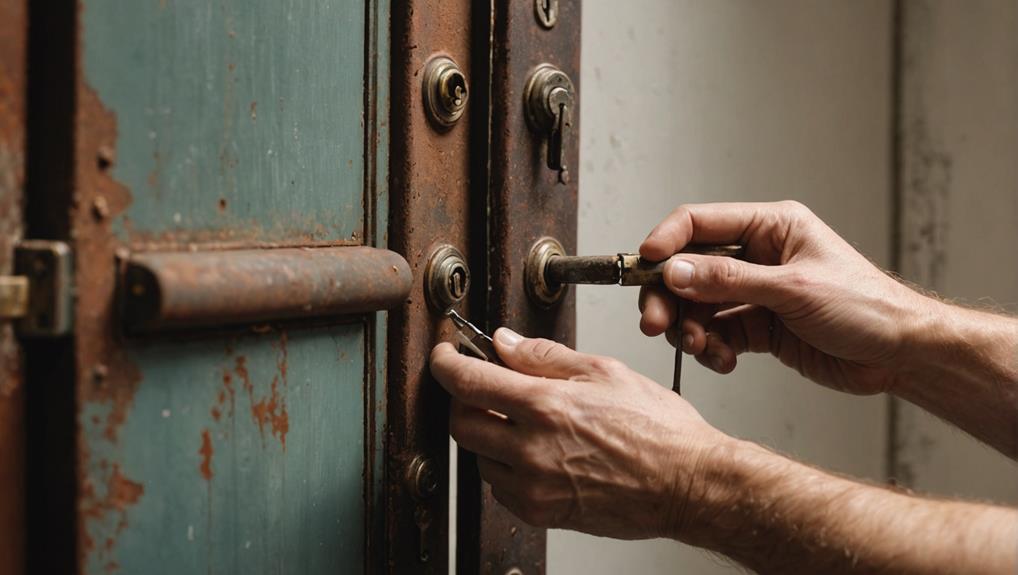
Sometimes, a simple cleaning can resolve the sticking issue in your lock mechanism. To start, gather a few basic tools: a can of compressed air, a soft cloth, and a cotton swab.
First, confirm the lock is in the open position. Then, use the compressed air to blow out any dust, dirt, or debris that might be causing the sticky lock problems. Holding the can upright and aiming it carefully will help avoid any damage. If the lock has been previously re-keyed, it might be more prone to sticking due to accumulated debris in the re-keying process, so regular maintenance is vital to understand lock re-keying.
Next, take the soft cloth and gently wipe the exterior of the lock. This helps maintain its appearance and prevents grime buildup. For any stubborn gunk, dampen a cotton swab with a little rubbing alcohol and carefully clean around the keyhole and other crevices.
Regular lock maintenance can greatly reduce the chances of future sticking. After cleaning, it's important to think about how lock lubrication can further enhance the lock's functionality.
A clean lock is more responsive, making it easier for you to serve others by providing reliable access to your space. By addressing these simple cleaning steps, you'll have a smoother and more dependable lock in no time.
Lubricate With Graphite Powder
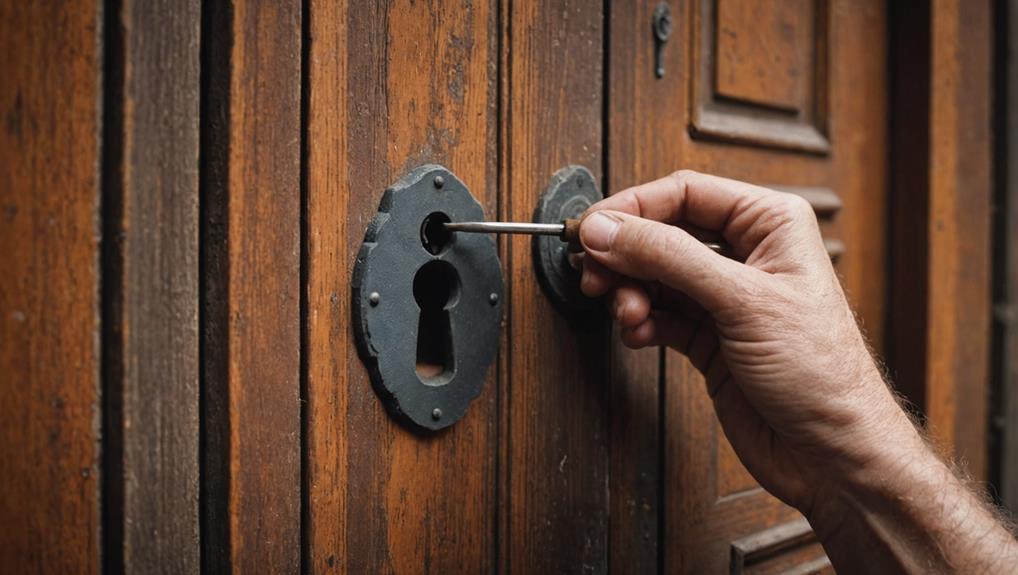
To keep your lock functioning smoothly, applying graphite powder is an effective solution. This method not only helps with a sticking lock or a lock not turning but can also be a cost-saving alternative to unlocking savings by avoiding unnecessary replacements.
Graphite powder is a dry lubricant, which means it won't attract dirt and debris, making it ideal for locks.
Start by ensuring the lock is clean and free from any grime or old lubricant. Once that's done, you can carefully apply a small amount of graphite powder directly into the keyhole. It's best to use a straw applicator for precision.
After applying, insert your key and turn it gently a few times to distribute the powder evenly throughout the locking mechanism. This should help ease any resistance you're feeling.
If you find that the sticking lock persists even after using graphite powder, it might be time to contemplate replacing sticky locks altogether. However, many times, this simple lubrication can restore your lock's functionality without the need for costly replacements.
Use Silicone Spray for Moisture
If your lock is sticking due to moisture, silicone spray can be a game changer.
It's crucial to recognize that moisture can lead to rust and corrosion, which may ultimately necessitate the costs involved in hiring a professional for lock replacement.
Silicone spray not only repels water but also provides a smooth finish for better operation.
Let's explore how to apply it effectively and guarantee your lock stays in top shape.
Benefits of Silicone Spray
Silicone spray is an excellent choice for combating moisture-related issues in locks. By applying this versatile lubricant, you not only enhance the performance of your locks but also protect them from rust and corrosion caused by humidity. When you care for your locks, you're ensuring safety and accessibility for yourself and others.
Here's a quick look at the benefits of using silicone spray:
| Benefit | Description |
|---|---|
| Moisture Resistance | Creates a barrier against dampness. |
| Long-lasting Lubrication | Reduces friction for smoother operation. |
| Prevents Rust | Protects metal components from corrosion. |
| Versatile Use | Suitable for various types of locks. |
Using silicone spray means you're taking proactive steps to maintain the security and functionality of your locks. Think of it as an act of service; by ensuring your locks work smoothly, you're helping everyone who relies on them. Regular maintenance not only benefits you but also those who may need to access locked areas in your home or business.
Application Tips and Techniques
Applying silicone spray correctly can make a significant difference in how effectively it combats moisture issues in your locks. When you're ready to use it, follow these simple steps to guarantee the best results:
- Clean the Area: Before applying the spray, make sure the lock is free from dirt and debris. Wipe it down with a clean cloth to prevent any interference with the silicone.
- Apply Evenly: Hold the spray about 6 inches away from the lock. Lightly coat the entire surface, making sure to target the keyhole and any moving parts. Avoid over-saturating, as a little goes a long way.
- Wipe Excess: After you've sprayed, use a clean cloth to gently wipe away any excess silicone. This will prevent buildup and guarantee smooth operation.
Maintenance for Longevity
Keeping your locks functioning smoothly requires regular maintenance, and using silicone spray is one of the best ways to prevent moisture-related issues. This spray helps create a protective barrier, keeping out water and dirt that can cause rust and corrosion. Just a quick application can greatly extend the life of your locks.
To use silicone spray effectively, first clean the lock with a dry cloth to remove any debris. Then, hold the spray can about six inches away from the lock and apply a light coating. Make sure to spray both the keyhole and the surrounding metal parts. After application, insert your key and turn it a few times to verify the spray penetrates all moving parts.
It's essential to perform this maintenance regularly, ideally every few months, especially in areas with high humidity or after heavy rainfall.
Adjust the Strike Plate
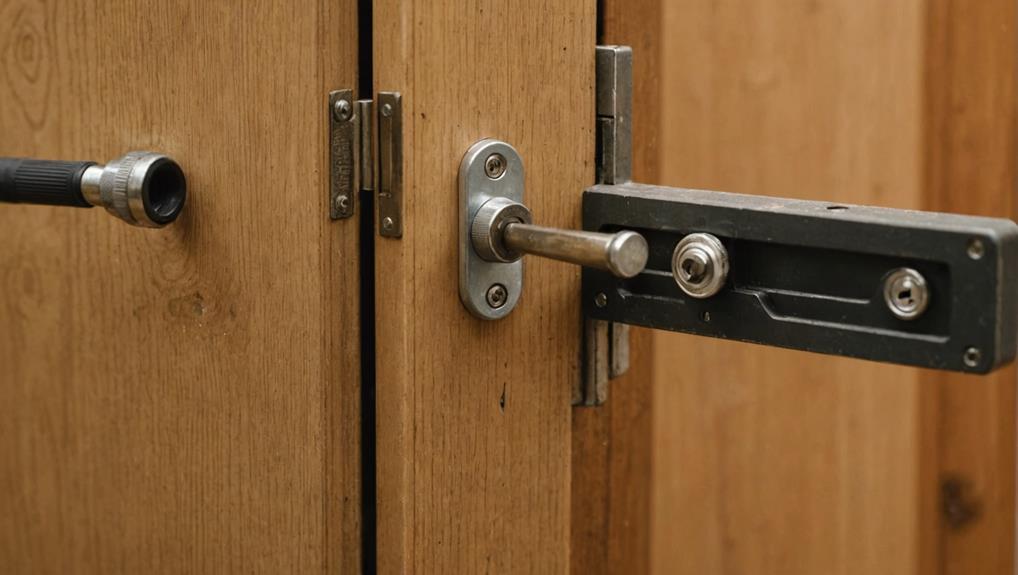
When your lock is sticking, adjusting the strike plate can often resolve the issue quickly.
The strike plate is the metal piece on the door frame that aligns with the lock. If it's out of position, it can cause friction and make your lock difficult to operate. In some cases, this misalignment can be due to seasonal changes affecting your door's fit, so it's important to check it regularly.
For a more thorough solution, you might also consider mastering deadbolt replacement if the issue persists.
Here's how you can adjust it:
- Inspect the Alignment: Close the door and check if the latch aligns with the strike plate. If it doesn't, you may need to move the strike plate slightly.
- Loosen the Screws: Use a screwdriver to loosen the screws holding the strike plate in place. Don't remove them completely; just enough to allow for adjustment.
- Reposition the Strike Plate: Gently shift the strike plate to align it with the latch. Tighten the screws once it's in the correct position, ensuring it's secure.
Check for Misalignment Issues
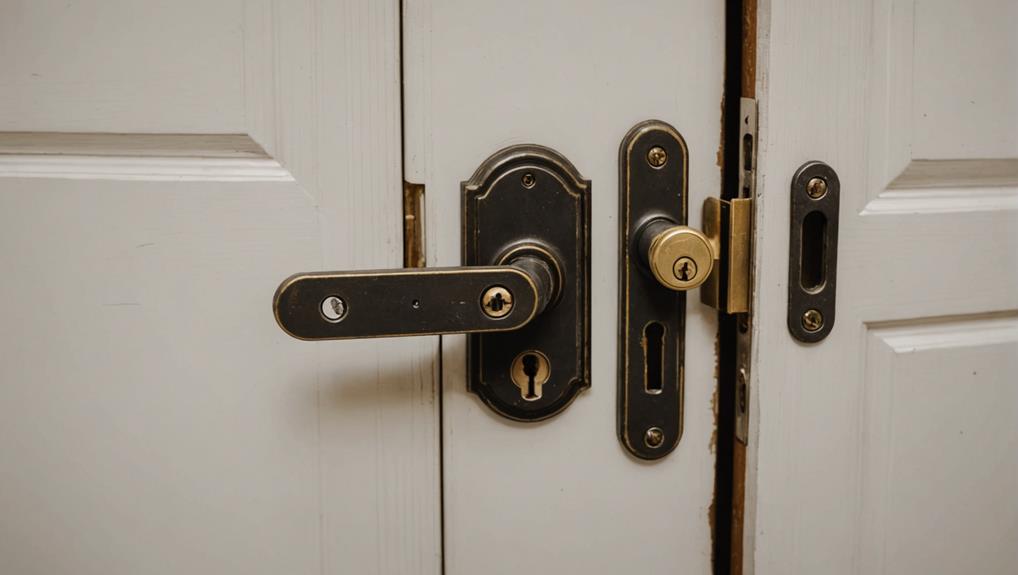
Check for Misalignment Issues
Misalignment issues can often be the root cause of a sticking lock. When your lock isn't aligning properly with the strike plate or the door frame, it can create resistance when you try to turn the key or latch. It's essential to recognize that if you experience recurring problems, it may also be a sign that your lock needs replacement soon.
To check for this, start by examining the door and frame. Look for any gaps or unevenness that might indicate misalignment.
Next, try closing the door slowly while observing how the lock engages with the strike plate. If you notice that the latch isn't properly aligning with the opening, it's time to take action. You might need to adjust the hinges or the strike plate itself to create a better fit.
If you find that the door is sagging or the hinges are loose, tightening the screws can often solve the problem. In some cases, you might need to shim the hinges to lift the door slightly.
Temporary Fixes for Sticking Locks
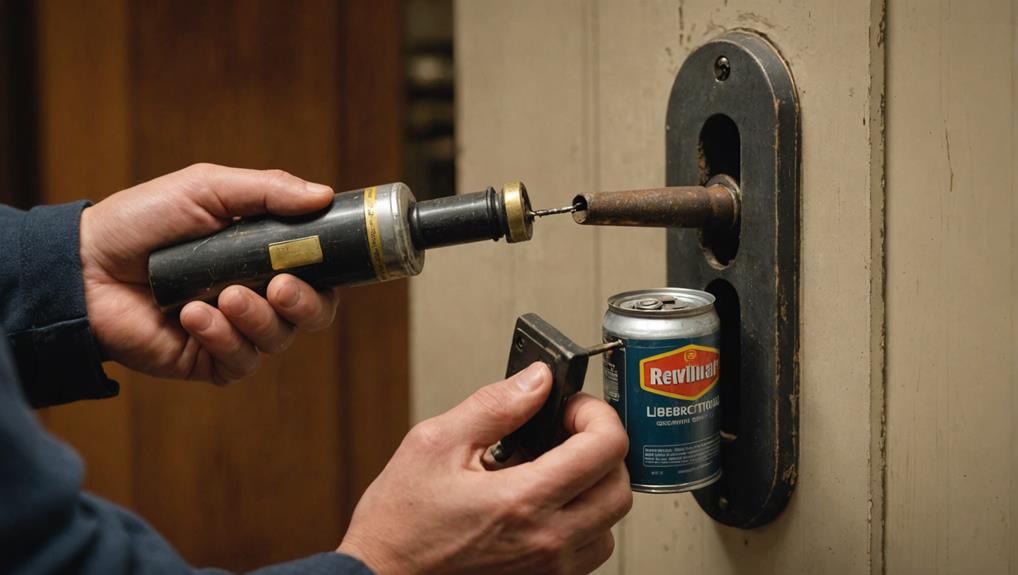
After addressing any misalignment issues, you might still find your lock sticking from time to time.
It's important to remember that improper maintenance can lead to bigger problems down the line, such as needing to avoid common mistakes during re-keying.
Don't worry; there are temporary fixes you can try to keep things running smoothly while you figure out a long-term solution.
Here are three quick remedies:
- Lubricate the Lock: Use a graphite-based lubricant or a silicone spray. Avoid oil-based products, as they can attract dirt. A few drops into the keyhole can work wonders.
- Wiggle the Key: If the lock feels stubborn, gently wiggling the key while turning it might help. This can relieve any internal pressure or binding within the lock mechanism.
- Heat the Key: If your lock is exposed to cold weather, warming the key slightly (not too hot!) can help it move more freely. Just be cautious not to burn yourself or damage the lock.
These fixes won't solve the problem permanently, but they can help you serve others by ensuring your door opens smoothly, keeping everyone safe and secure.
When to Replace the Lock
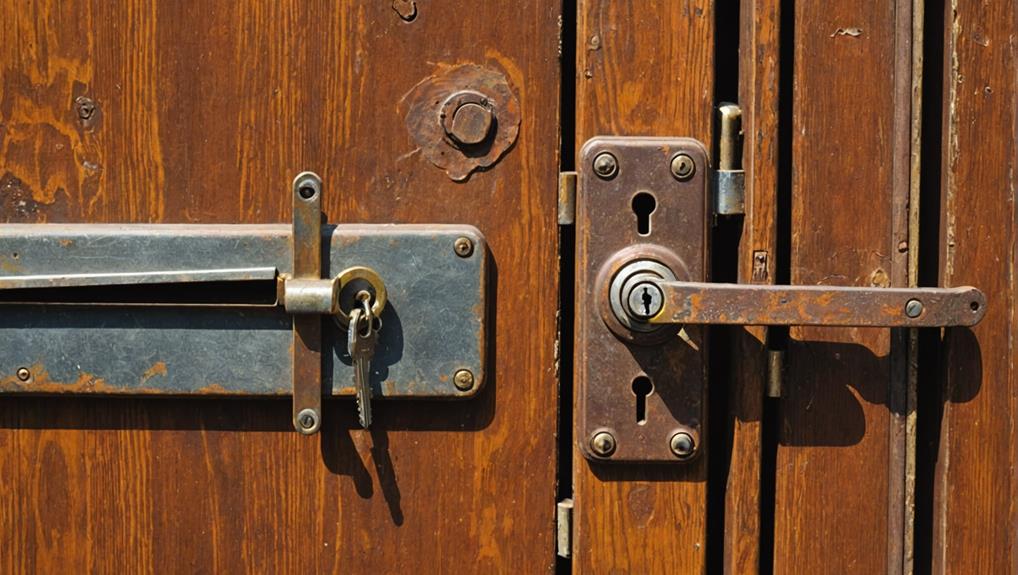
If your lock is consistently sticking despite your best efforts, it might be time for a replacement.
Locks can wear down over time due to various factors, such as exposure to the elements or frequent use, which can lead to malfunction.
Look for signs like difficulty turning the key or visible damage that could indicate it's beyond repair.
Understanding the types of locks available can help you choose the right one for your needs, as different locks vary in durability and cost, influenced by aspects like replacement costs.
Signs of Replacement Needed
Over time, your lock may show clear signs that it needs replacing.
Recognizing these signs can help you serve your home and loved ones better by ensuring their safety.
Here are three key indicators that it's time for a replacement:
1. Frequent Sticking: If your lock sticks often, it's a sign of wear and tear.
You shouldn't have to wrestle with it each time you open your door.
2. Difficulty Turning the Key: If you find yourself struggling to turn the key or if it feels loose, the internal mechanisms might be failing.
This can lead to a lock that's unreliable when you need it most.
3. Visible Damage: If you spot rust, cracks, or other visible damage, it's time to evaluate a replacement.
A compromised lock can put your security at risk.
Types of Locks Available
Knowing when to replace a lock is just as important as understanding the signs that indicate it's time for an upgrade. There are several types of locks available, each with its unique features and benefits, helping you serve others by ensuring their safety.
Deadbolts are a popular choice for exterior doors, providing added security due to their robust design. If you notice your current deadbolt sticking or failing to engage properly, it might be time for a replacement.
Smart locks have become increasingly popular, offering keyless entry and remote access, which can enhance convenience for those you serve. If your smart lock frequently malfunctions, consider replacing it with a more reliable model.
Padlocks are versatile and can secure everything from gates to storage units. If your padlock shows signs of wear or difficulty opening, it's time for a new one.
Preventative Maintenance Tips
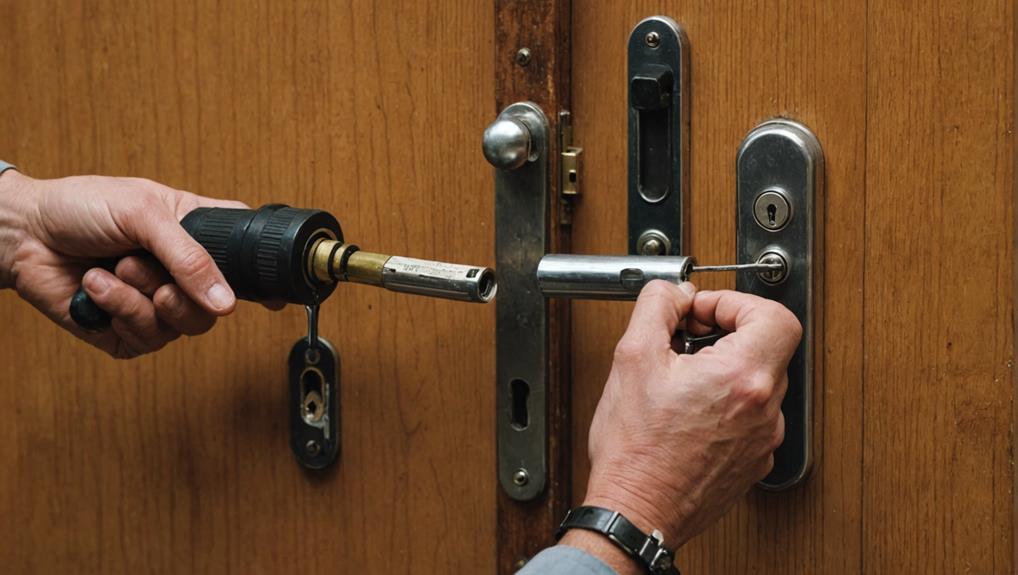
Regular maintenance is the key to keeping your locks functioning smoothly and preventing them from sticking. By taking a few simple steps, you can guarantee that your locks serve you well for years to come.
Additionally, if you plan on tackling any lock re-keying yourself, it's beneficial to have the right tools on hand, such as essential tools for DIY lock re-keying.
Here are three essential tips to help you maintain your locks:
- Clean your locks regularly: Dust and grime can build up inside the lock, causing it to stick. Use a soft cloth or a can of compressed air to remove debris from the exterior and interior of the lock.
- Lubricate your locks: Applying a suitable lubricant can work wonders. Use a graphite-based lubricant or a silicone spray, avoiding oil-based products, which can attract dirt. A few drops in the keyhole can keep the mechanism running smoothly.
- Inspect your locks: Regularly check for signs of wear or damage. If you notice any issues, address them promptly to prevent further problems.
Frequently Asked Questions
Can I Use Oil Instead of Graphite Powder for Locks?
You can use oil instead of graphite powder for locks, but it's not the best choice.
While oil can lubricate, it tends to attract dirt and dust over time, which may lead to more sticking issues.
Graphite powder is cleaner and won't gum up your lock.
If you want to keep your locks smooth and functioning well, consider sticking with graphite for a longer-lasting solution.
How Often Should I Perform Preventative Maintenance on My Locks?
Locks need love and care to keep them functioning flawlessly.
You should perform preventative maintenance on your locks at least twice a year, or more often if you live in a humid or dusty area.
Regularly checking and cleaning helps prevent problems down the line, ensuring reliable security.
What Tools Do I Need to Clean a Lock?
To clean a lock, you'll need a few simple tools. Grab some graphite or silicone spray to lubricate the mechanism, a cloth to wipe away dirt, and a small brush to reach tight spots.
If there's stubborn grime, a cotton swab can help too. Don't forget a flashlight to inspect the lock closely.
With these tools, you can keep your locks functioning smoothly and guarantee they serve you well for years.
Is It Safe to Pick a Sticking Lock?
Is it really safe to pick a sticking lock?
While it might seem tempting, you should think twice. Picking a lock can damage it or even leave you locked out for good.
Instead, consider using a lubricant or calling a locksmith. You're serving yourself and others by ensuring the lock is fixed properly.
How Can I Tell if a Lock Is Beyond Repair?
To tell if a lock's beyond repair, check for visible damage like cracks or corrosion.
If it's difficult to turn, even after cleaning and lubricating, it might be time to replace it.
Listen for unusual noises when you try to operate it; that could indicate internal issues.
If the key doesn't fit or turns too easily, it's likely compromised.
Trust your instincts; if it feels unreliable, replacing it's often the best option.
Conclusion
To sum up, tackling a sticking lock doesn't have to be a hassle. Did you know that nearly 15% of homeowners experience issues with their locks at some point? By identifying the cause, cleaning, and lubricating your lock, you can restore its smooth function. Regular maintenance not only extends the life of your lock but also keeps your home secure. Don't wait for a bigger problem—take action now and keep your locks in top shape!

